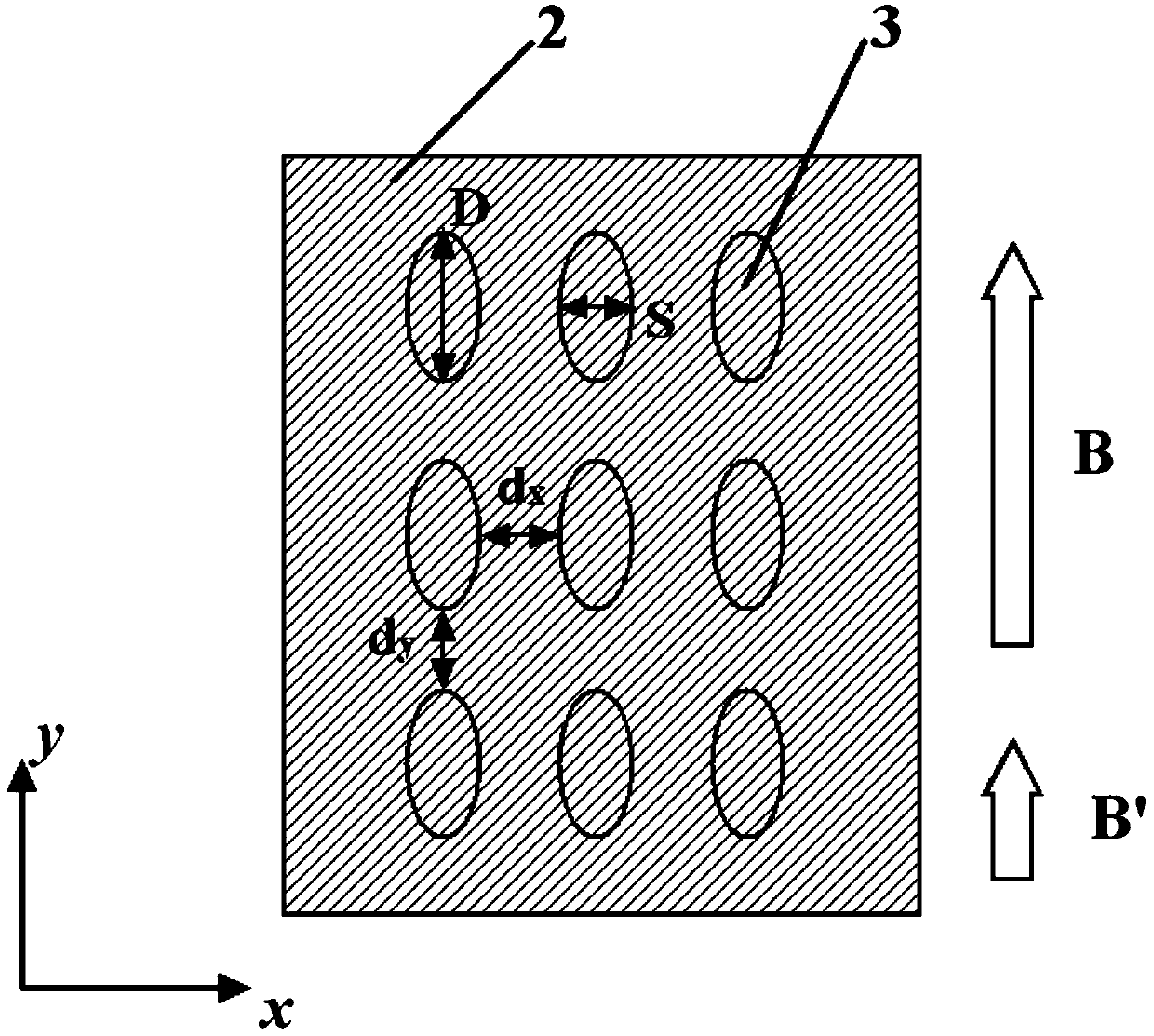A weak magnetic detection device based on 2d artificial magnon crystals
A magnon and magnetic detection technology, which is applied in the directions of magnetic resonance measurement and the size/direction of the magnetic field, can solve the problems of the absorption peak shift of the surface magnetostatic wave, and achieve the effects of simple structure, improved sensitivity and accuracy, and abundant resources
- Summary
- Abstract
- Description
- Claims
- Application Information
AI Technical Summary
Problems solved by technology
Method used
Image
Examples
preparation example Construction
[0034] A method for preparing a weak magnetic detection device based on 2D artificial magnon crystals, comprising the following steps:
[0035] 1) The non-magnetic single crystal substrate is ultrasonically rinsed with acetone or ethanol, and then cleaned with deionized water. The selection of materials for the non-magnetic single crystal substrate and the ferromagnetic thin film layer 2 should meet the requirements of material growth kinetics (ie: lining The lattice parameters of the bottom material and the ferromagnetic thin film layer material need to match or be close);
[0036] 2) Using physical or chemical methods such as magnetron sputtering, pulsed laser deposition or chemical vapor deposition, to prepare a ferromagnetic thin film layer 2 on a non-magnetic single crystal substrate;
[0037] 3) An array of patterned ferromagnetic elements 3 arranged periodically is prepared on the ferromagnetic thin film layer 2 by photolithography or ion beam etching.
[0038] The ann...
Embodiment 1
[0040] Figure 2a with Figure 2b They are schematic diagrams of top-view and bottom-view structures implementing a 3×3 array 2D magnon crystal weak magnetic detection device, respectively.
[0041] Such as Figure 2a with Figure 2b As shown, the material of the non-magnetic substrate 1 is a 500 μm thick single polished (100) silicon wafer with a natural oxide layer on the surface. The ferromagnetic thin film layer 2 is made of permalloy soft ferromagnetic material, and the thickness t1 of the thin film layer is 5 nm. The material of the periodically arranged patterned ferromagnetic element 3 array is also made of permalloy, and the periodic arrangement is realized in a 3×3 lattice structure. The width S of the short side and the width D of the long side are both 80 nm, and the thickness t2 is 5 nm. , and the short-side distance dx and long-side distance dy between two adjacent elements are both 10 nm.
[0042] The device is placed in a constant bias magnetic field envir...
Embodiment 2
[0047] Figure 2a with Figure 2b They are schematic diagrams of top-view and bottom-view structures implementing a 3×3 array 2D magnon crystal weak magnetic detection device, respectively.
[0048] Such as Figure 2a with Figure 2b As shown, the material of the non-magnetic substrate 1 is a 500 μm thick single polished (100) silicon wafer with a natural oxide layer on the surface. The ferromagnetic thin film layer 2 is made of permalloy soft ferromagnetic material, and the thickness t1 of the thin film layer is 5 nm. The material of the periodically arranged patterned ferromagnetic element 3 array is also made of Permalloy, and the periodic arrangement is realized in a 3×3 lattice structure. The width S of the short side is 60 nm, the width D of the long side is 80 nm, and the thickness t2 is 5 nm, and the short-side distance dx and long-side distance dy between two adjacent elements are both 10 nm.
[0049] The device is placed in a constant bias magnetic field environ...
PUM
 Login to View More
Login to View More Abstract
Description
Claims
Application Information
 Login to View More
Login to View More - R&D
- Intellectual Property
- Life Sciences
- Materials
- Tech Scout
- Unparalleled Data Quality
- Higher Quality Content
- 60% Fewer Hallucinations
Browse by: Latest US Patents, China's latest patents, Technical Efficacy Thesaurus, Application Domain, Technology Topic, Popular Technical Reports.
© 2025 PatSnap. All rights reserved.Legal|Privacy policy|Modern Slavery Act Transparency Statement|Sitemap|About US| Contact US: help@patsnap.com



